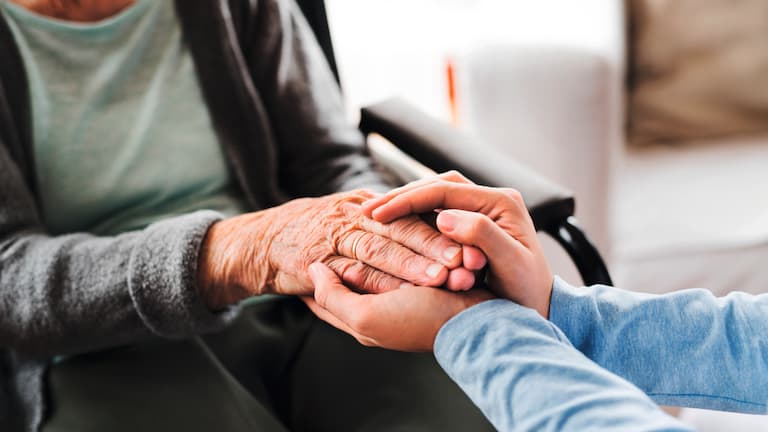
How can tomorrow’s carer support quality of life?
Future residents will have a greater understanding of technology and demand more when it comes to entertainment. Predictions also suggest that the elderly will be given more independence thanks to advancements in robotics along with greater research on healthier lifestyles and cures for certain illnesses. Tomorrow’s care home will need to ensure that its carers are equipped with the skills and training required to support the next generation of resident. Whether that’s monitoring health and wellbeing, administrating medication, or providing emotional support and companionship.
Here, we highlight three areas that can help make a difference to our future carers and how this will positively impact quality of life for their residents.
People-centred care

As new generations of residents enter the care system; a tech-savvy elderly population that will have different lifestyle expectations and are used to a high degree of individualisation; care professionals will need to find ways to accommodate their bespoke needs. Whilst in today’s care home this could be reading a book or playing a game of domino’s, residents of tomorrow will likely be wanting to access the internet or play their favourite video games. It is the responsibility of the care provider to nurture this and help an individual find activities that can enhance their life. This means focusing more attention on people-centred care, where residents are treated as individuals and equal partners in their care plan, rather than task-focused care, where everything is done for the resident.
Whilst digitalisation and technology will be integrated into many of the activities enjoyed by residents, it’s important that carers also extend personalisation to other experiences and routines.
An analysis on ‘What care homes of the future should look like’ highlighted how some care homes in Europe are already leading by example when it comes to changing mindsets around care models. One care home in the UK, for instance, has been designed around the everyday rhythms of life: going shopping, doing the washing up, laying the table etc. It also mimics real life scenarios by providing a health clinic with a waiting room on-site, a hairdresser, and even a shop selling fruit and vegetables. Residents are treated like ‘customers’ and staff do as little or as much as needed. A similar model in the Netherlands has also been created for dementia patients. Staff don’t wear uniforms and are all trained in hospitality. According to the analysis, both examples show how the focus should be placed on ensuring residents can enjoy life and live in the moment, even in their later years.
Training to support care

Levels of care required by a resident can vary depending on the health conditions they have. It should not be a one-size-fits-all approach, especially as our future residents will have different types of illnesses than those experienced today; existing conditions such as dementia are expected to worsen; and there is a growing awareness of neurodiverse disorders e.g. ADHD and autism.
Whilst basic training is provided to all care professionals when they start their career, skills and knowledge can be built further by attending specialist training programmes. In addition to important standard training courses such as the special handling of dementia, carers will need to be educated in other areas such as supporting residents on the spectrum through to developing their understanding of identity as more people will identify as part of the LGBTQIA+ community.
The care professional of tomorrow will also need to be open to learning and adopting new technologies to support activities. This could be using digital solutions to help record and monitor a resident’s health; virtual reality to aid training and simulate real life scenarios within the care home; and working together with robots to provide essential care to residents.
Solutions to free-up time

Some of the biggest challenges in the care sector today is a lack of time caused by high levels of administration and low staffing levels resulting from issues with recruitment and retention. This is an issue that will remain prevalent for the foreseeable future. Whilst technology is one of the most promising solutions to improve efficiencies around the care home and free-up staff to care for residents, there are additional solutions that can also have a positive impact.
Helping residents stay independent for longer when living in a care facility not only helps improve their quality of life but it means that carers can spend more time with those who need additional support. This closely links to the importance of providing people-centred care as encouraging residents to stay healthy and active and allowing them to have autonomy will help promote independence. Care homes who also focus on bringing efficiencies to secondary processes (everything that supports core operations such as the laundry) will help free-up even more time for care professionals to focus on residents.
For example, our commercial laundry and dishwashing solutions have fast but thorough cycles which support the prevention of infection, offer specialised care programmes, and can record machine data to improve processes. Miele Professional technicians are also on hand to help ensure machines are working to optimum standards and downtime is at a minimal. Additionally, Miele machines are very intuitive in their handling and minimal training is required, meaning carers can reinvest this time in other types of training that can improve care for residents.
Supporting quality of life
The future will be here before we know it. As new generations of residents begin to enter care, today’s care home needs to provide its care professionals with the training and resources to help deliver quality of life for the developing needs of tomorrow’s residents.
Together, we can make a difference to your residents’ quality of life. Learn more about how Miele Professional solutions can help achieve this here.
- 1.careandnursing-magazine: https://careandnursing-magazine.co.uk/technological-future/
- 2.savills: https://www.savills.com/research_articles/255800/333726-0
- 3.20Economics: https://www.statista.com/topics/7965/residential-care-in-europe/#topicOverview
- 4.hee.nhs: https://www.hee.nhs.uk/our-work/person-centred-care
- 5.theguardian: https://www.theguardian.com/social-care-network/2017/jul/31/care-homes-future-paul-burstow
- 6.healthdata: https://www.healthdata.org/research-analysis/health-policy-planning/health-forecasting
- 7.Statista: https://www.statista.com/topics/7965/residential-care-in-europe/


